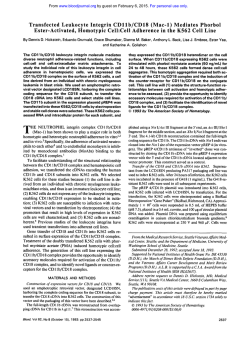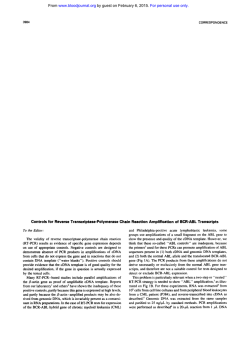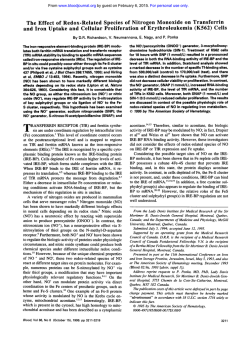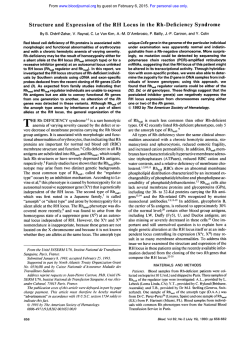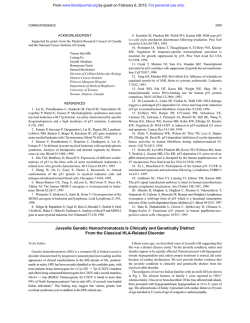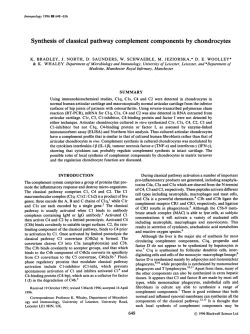
Expression of RHD and RHCE Gene Products Using Retroviral
From www.bloodjournal.org by guest on February 6, 2015. For personal use only. Expression of RHD and RHCE Gene Products Using Retroviral Transduction of K562 Cells Establishes the Molecular Basis of Rh Blood Group Antigens By J.S. Smythe, N.D. Avent, P.A. Judson, S F . Parsons, P.G. Martin, and D.J. Anstee Retroviral-mediated gene transfer using cDNA transcripts of the RHD and RHCE genes resulted in the isolation of K562 clones expressing D and G or c and E antigens, respectively. These results represent the first direct demonstration that the RHD gene encodes the D and G antigens and the RHCE gene encodes the c and E antigens. Both c and E antigens were expressed after transduction of K562 cells with a single cDNA, indicating that thec antigen does not arise by alternative splicing (exon skipping) of the product of the RHCE gene, as has been suggested. 0 1996 by The American Society of Hematology. T merase chain reaction (RT-PCR) of total RNA purified from reticulocytes" of Rh phenotype CDe. RT-PCR was performed in a PerkinElmer DNA thermal cycler (Perkin-Elmer, Norwalk, using CT) avian myeloblastosisvirusreversetranscriptase,oligodTzc,(Pharmacia, Uppsala, Sweden) and Taq polymerase (Perkin-Elmer) essentially as described." The primers were based on the cE cDNA 5' and 3' noncoding nucleotides -32 to -5 (exon 1 sense) and 1,300 to 1,327 (exon10anti-sense),respectively.Transformation of Escherichia coli XL-l Blue competent cells (Invitrogen) with pCRII and subsequentvectorDNApreparation(Qiagen,Dorking,UK)wasdone according to the manufacturers' instructions. A colony of cells containing only DcDNAwasselectedfollowingthesequencing of several vectorhnsert DNA preparations. The D cDNA sequence differed from that d e ~ c r i b e din ' ~ that it contained a C,,, to G (IleIIqto Met)changeinthecodingregion(previouslyreportedi5)andan to G change in the 3' noncoding region. The Fyh cDNA( 1,062 bp) wasclonedintoBluescriptvector(Stratagene,LaJolla,CA) following amplification of genomic DNA from an Epstein-Barr virus (EBV) lymphoblastoid cell line derivedfrom an individual of phenotype Fy(a-b+) using primers based on the 5' and 3' Fyh noncoding regions as described." The D and cE cDNAs were subcloned separately into the pBabe puro retroviral vector (kindly provided by Dr H. Land, ICRF, Lonsite." TheFyhcDNAwas don, UK) using theEcoRIrestriction subcloned into pBabe puro using the BamHI and Sal I restriction sites. The pBabe puro vector is based on the Moloney murine leukaemia virus (MoMuLV). Expression of inserted genes is driven by the MoMuLV long terminal repeat while the puromycin resistance gene is expressed from the SV40 early promoter 3' of the cloning site. Vector DNA preparation was as described above. CorrectRh cDNA orientation in pBabe was established by BamHI and Kpn I restriction and DNA sequence analysis. Trunsfection of the packaging cell line and retroviral supernatant GP + env production. Amphotropicretroviralpackagingcells, AM12,IX from Genetix Pharmaceuticals (Rye, NY), were cultured in Iscove's modified Eagle's medium supplemented with 10% fetal bovineserum(IMEMIFBS)andincubatedat 37°C in a 5% CO2 humidified incubator. Cells (S X IO') were transfected with pBabe constructs (10 to 25 pg) using calcium phosphate precipitation essentially as described.'? Four hours after the addition of DNA the culture medium was replaced with 15% glycerol in phosphate-buffered saline (PBS) for 3 minutes and this in turn was replaced with IMEM/ FBS. After 2 days the medium was replaced with fresh IMEMIFBS supplemented with puromycin (3 pg mL l ; Sigma, St Louis, MO). Approximately 2 weeks later individual puromycin resistant colonies were transferred to culture flasks using trypsin (Sigma) to detach the cells. The supernatants were collected from near-confluent cells incubated overnight at 3 3 T , filtered (0.45 pm), and stored frozen. Retroviral transduction of K562 cells. K562 cells were obtained fromtheEuropeanCollection of AnimalCellCultures(Porton Down, Salisbury, Wiltshire,UK). Cells (IO') were incubated at37°C in IMEMFBS supplemented with viral supernatant (1.0% vol/vol) andpolybrene (8 pg mL.~'; Sigma). After 4 hoursthecells were centrifuged at 400g for S minutes and resuspended in IMEWFBS. HE RH SYSTEM is the most complex of the 23 blood group systems found on human red blood cells.' Antibodies to Rh system antigens (especially anti-D) are of clinical significance because they may cause hemolytic disease of the newborn or transfusionreactions.' In recentyears, there have been considerable advances in our understanding of the biochemistry and geneticsof Rh antigens.'-5 Available evidence suggests that the Rh antigens result from at least two highly homologous genes (RHD and RHCE) located at chromosome 1 p34-p36. The RHD gene is deleted in most white individuals who lack the D antigen.h TheRHCE gene gives rise to the allelic antigens C/c and E/e. It has been proposed that C/c and E/e are located on different polypeptides which arise by alternative splicing of the primary transcript of the RHCE Formal proof that the RHD and RHCE genes encode for the antigens of the Rh system and that alternative splicing of the RHCE gene product gives rise to separate polypeptides with C/c or E/e antigens, respectively, has been lacking because previous attempts to expressthese genes in eukaryotic cells have been unsu~cessful.~~'" In this report we describe the use of retroviral gene transfer to generate stable clonesof K562 cells expressing theD and G, or c and E blood group antigens. The results provide the first direct evidence that the putative RHD gene gives rise to D and G antigens and that the putative RHCE gene gives rise to c and E antigens. However,the results refutethe hypothesis that the c and E antigensarise by alternative splicing of the product of the RHCE gene. MATERIALS AND METHODS Cloning of Rh D and cE cDNAs into the pBabe puro retroviral vector. The Rh cE cDNA (1,463 bp)wasclonedintoBluescript vector as previously described." It contained 41 nucleotides of 5' and 171 nucleotides of 3' noncoding sequence and terminated with an A,, tract. The Rh D cDNA (1,359 bp) was cloned into pCRII vector (Invitrogen, San Diego, CA) after reverse transcriptase-poly- From the International Blood Group Reference Laboratory, Bristol, UK. Submitted August 22, 199.5; accepted November 7, 1995. Address reprint requests to J.S. Smythe, MPhil, International Blood Group Reference Laboratory, Southmead Rd, Bristol BSI0 5ND, UK. The publicationcosts of this article were defrayed in part by page charge payment.This article must therefore be hereby marked "advertisement" in accordance with l 8 U.S.C. section 1734 solely to indicate this fact. 0 1996 by The American Society of Hematology. 0006-4971/96/8707-0033$3.00/0 2968 Blood, Vol 87, No 7 (April l), 1996: pp 2968-2973 From www.bloodjournal.org by guest on February 6, 2015. For personal use only. EXPRESSION OF RHD AND RHCE GENES Two days later the cells were recultured in IMEM/FBS supplemented with puromycin (3 pgd - l ) and transferred to a 96-well microplate (0.2 mL/well). After 2 to 3 weeks puromycin-resistant stable-transduced clones from wells containing only a single discrete colony were transferred to 24-well plates and expanded before flow cytometric analysis. The clones exhibiting the highest levels of Rh expression were selected using BRIC 69 and those with the highest levels of Fyb expression using CBC-512 (vide infra). Antibodies and red blood cells. BRIC 69 is a murine monoclonal antibody that binds to Rh polypeptides.” Murine monoclonal antiFy3, (CBC-512, IgG) and human monoclonal anti-E (H4-1 G-4, IgG) were provided by Dr M. Uchikawa (Japanese Red Cross, Shibuya-ku, Japan). Purifiedhuman monoclonal anti-D, BRAD 5 (IgGI”) was used at 50 pg/mL (diluted in PBS/l% bovine serum albumin [BSA], 0.1% NaN, [PBS-A]). Human monoclonal anti-C (MS252, IgG3), anti-c (MS47, IgG3), anti-e (MS70, IgG3), and Anti-G (MSI, IgG3) were provided by Dr K. Thompson (IGRI, Oslo, Norway). Red blood cells of known Rh phenotype were available from the National Blood Service, Bristol. Flow cytometric analysis. K562 clones transduced with D cDNA (K562/D) or cE cDNA (K562/cE) were tested for antigen expression by flow cytometry (FACStar Plus; Becton Dickinson, Mountain View, CA). Mean fluorescence intensity (FLI) was used asa measure of antibody binding. The specificity of the antibodies used was confirmed using red blood cells of the appropriate phenotype (data not shown). A K562 clone transduced with cDNA corresponding to the Fyb blood group gene (K562/Fyb)and untransduced K562 cells were usedas controls. K562 cells (2 X IO5) or redblood cells (0.5% suspension) in PBS-A (50 pL) were incubated with antibody (50 pL) for 1 hour at 37°C. Cells were washed once inPBS-Aand incubated with (Fab’), fragments of rabbit-antihuman IgG or rabbitantimouse IgG affinity-purified fluorescein isothiocyanate (F1TC)labeled (1/20, 50 pL, DAKO, Glostrup, Denmark) for 1 hour at room temperature. The sample volume was adjusted to 300 pL with PBS-A before analysis. mRNA preparation and RT/PCR amplification of pBabe specijc sequences from K562 cells. Oligo d(T,z.z8)magnetic beads were used to prepare mRNA according to the manufacturers instructions (Dynal, Oslo, Norway). Synthesis of cDNA was from 1 pg of mRNA as described above using oligo d(Tlz.la)(Pharmacia). Approximately 100 ng of cDNA was used as the template for PCR (94°C 1 minute, 60°C l minute. 72°C 2.5 minutes, 35 cycles) with 50 pmol of each primer. Two pairs of primers were used. One set (PI and P2) corresponded to pBabe sequences 5’ and 3‘ of the cloning site (P1 sense 5’-CCC TTT ATC CAG CCC TCA CTC CT-3’ and P2 anti-sense 5’-CCC TAA CTG ACA CAC A’M CCA CAG-3’), respectively. The second set consisted of a primer (P3) which corresponded to pBabe sequence 5’ of the insert site (P3 sense 5’-GCC TCG ATC CTC CCT TTA TCC-3‘) and the antisense primer to cE cDNA 3’ noncoding region (exon 10 antisense, described above). Sequencing of cDNA. Amplified Rh-specific PCR products were sequenced using dye-labeled terminator chemistry on a 373A Applied Biosystems automated sequencer (Warrington, UK). Set 1 and Set 2 primers and primers complementary to sequences common to both the cE and D coding regions were used for sequencing. Rh typing of genomic DNA. Genomic DNA was prepared using the proteinase Wsodium dodecyl sulfate (SDS)/EDTA method essentially as de~cribed.’~ Rh D-specific PCR was performed using primers specific for intron 4 and exon 10 of the RHD Allele-specific PCR for c and E alleles was performed as described.” RESULTS Flow cytometric analysisof K562 clones transduced with putative D a n d CE genes. K562fDandK562/cE clones, 2969 prepared as described in Materials and Methods, were tested for Rh antigen expression byflow cytometric analysis. A W62/Fyb clone and untransduced K562 cells were used as controls. The selected clones were examined using human monoclonal antibodies to Rh system antigens (D, C, E, C, e, and G). The results for a K562fD clone are shown in Fig 1A and Table 1. Anti-D and anti-G bound much morestrongly to this clone than to the K562/Fyb clone with increases in mean fluorescence intensity (FLI) from 3.3 to 15.2 and 4.5 to 11.0 for anti-D and anti-G, respectively. Antibodies to C, E, C, and e antigens did not detect comparable changes in antigen expression, although anti-c and anti-e did show very minor increases in binding to K562/D cells (Table 1). The results obtained for a K562/cE clone are shown in Fig 1B. Anti-c and anti-E boundmuchmore strongly to K562/cE cells than to K562/Fybcells with increases in FLI from 4.7 to 24.4 (anti-c) and from 2.4 to 38.8 (anti-E), respectively (Table 1). Antibodies to D, G, C, and e antigens did not detect comparable changes in antigen expression, although anti-D, anti-G, and anti-e didshowveryminor increases in binding to K562kE cells. The FLI ofRh antibody binding to untransduced K562 cells and KS62/Fyb cells was compared with that of tissue culture medium (TCM, Table 1). Antibodies to C, E, and e antigens gave almost identical FLI values to TCM with both untransduced K562 cells and K562/Fyb cells. Antibodies to D, G, and c antigens gave slightly higher FLI values than TCM with both cell preparations (Table 1). In a separate experiment, murine monoclonal anti-Fy3 gave almost identical F L I values to those obtained with TCM with K562/D, K562/cE, and untransduced K562 cells (range 2.2 to 2.5) while K562/Fyb gave an FLI value of 24.2 (data not shown). Demonstration of D and cE rnRNAs in the K542# clone and the K562kEclone,respectively. The presence of mRNAs arising from retroviral transduction in K562/D and K562kE clones was determined by isolation of mRNA followed by RT-PCR and DNA sequence analysis. Two sets of oligonucleotide primers were used. Primer set 1 (P1 and P2, see Materials and Methods) wasspecific for vector (pBabe puro) sequences flanking the multiple cloning site. Using these primers a product of 1S 5 kb was amplified from K562/D cDNA and a product of 1.15 kb from the K562/Fyb cDNA. No products were obtained from untransduced K562 cells or from the K562kE clone (Fig 2). Primer set 2 (P3 and an Rh specific exon 10 antisense primer, see Materials and Methods) amplified a product of 1.5 kh from the K562/ CE cDNA and from the K562/D cDNA, butno products were obtained using cDNA from untransduced K562 cells or the K562/Fyb clone (Fig 2). The PCR product of 1.S5 kb obtained from K562/D cDNA with primer set 1 was sequenced (see Materials and Methods). It contained the expected 5’ and 3’ pBabe vector flanking sequences and a D cDNA sequence (from nucleotide -32 to 1327) identical to that of the cDNA originally subcloned into pBabe. The PCR product of 1.5 kb obtained from K562kE cDNA with primer set 2 was sequenced (see Materials and Methods). It contained the expected pBabe 5’ flanking sequence and a cE cDNA sequence corresponding From www.bloodjournal.org by guest on February 6, 2015. For personal use only. 2970 SMYTHE ET AL A B IDI 11 IC 10 ' L rn J Io; n 4 4 Fig 1. Flow cytometric analysis of transduced K562 cells using monoclonal Rh antibodies. (A) (-1, K562/D; i--4, K562/Fyb. (B) (-1, K562/cE; of cells is plotted on the ordinate and the fluorescence intensity on the abscissa. Experimental details are in Materials and Methods. (---l, K562/Fyb. The number to nucleotides -41 to 1327 of that originally subcloned into pBabe. A product of the expected sizeI6(1.15 kb) was amplified from the K562/Fyb cDNA with primer set 1 (Fig 2). Rh typing of genomic DNA from untransduced and transduced K562 cells. Analysis of genomic DNA derived from untransduced K562 cells, K562/D, and K562/Fyb showed the presence of D- and c- (data not shown), but not E-specific sequences (Fig 3). The presence of an E-antigen-specific product (149 bp) in genomic DNA derived from the K562/ Table 1. Rh Antigen Expression on Untransduced K562 Cells and K562 Clones Transduced With D, cE, and Fyb cDNA ~ Rh Antibody TCM Cells K562 K562/Fyb K562/D K562/cE 2.8 2.8 2.7 2.8 Anti-D Anti-C Anti-G Anti-E Anti-c Anti-e 3.8 3.3 15.2 4.5 2.8 2.5 2.6 2.9 4.2 4.5 11.0 5.9 2.5 2.4 2.7 38.8 5.2 4.7 6.1 24.4 2.8 2.6 3.8 3.4 Mean fluorescence intensity (FLI) was used as a measure of antibody binding. Antibody binding is compared with background fluoin tissue culture rescence obtained when the cells were incubated medium (TCM). cE clone established that integration of the cE cDNA had occurred (Fig 3). DISCUSSION The purpose of the present work was to investigate K562 cells as a model in vitro system for the study of RH gene expression. Previous attempts to express Rh cDNAs by transfection of K562 cells have metwith little succe~s.~~'" In the present study we have used retroviral gene transfer to transduce K562 cells with cDNAs corresponding to the putative RHCE gene (syn RhIXb=; Rh30A1'), and the putative RHD gene (syn RhXIIIl4; Rh13I5;RhPIIz5).The levels of D, c, E, C, e, and G antigen expression on these transduced cells were compared with cells transduced with cDNA corresponding to Fyb glycoprotein gene16.26-z8 and with untransduced K562 cells. K562/D cells gave much higher FLI valueswith anti-D and anti-G in comparison with K562/Fyb cells (Fig lA), K562kE cells, or untransduced K562 cells (Table 1). In contrast, K562/cE cells gave much higher FLI values with anti-c and anti-E than the other cells tested (Fig 1B and Table 1). The levels ofRh antigen expression on K562/Fyb cells were virtually identical to those on untransduced cells (Table 1). The expression of D, c, and E antigens From www.bloodjournal.org by guest on February 6, 2015. For personal use only. 2971 EXPRESSION OF RHD AND RHCE GENES 1 2 3 4 5 6 7 8 9 10 I I 1213 kb 3.0 2.0 1.6 1.o 0.5 Fig 2. Demonstration of D and c€ mRNAs in K562/D and K562/cE cells. mRNA preparation and RT-PCR was as described in Materials and Methods. Lanes 2 through 6, PCR performed with set 1 primers; lanes 8 through 12, PCR performed with set 2 primers; 2,8, no template control; 3,9, cDNA from untransduced K562 cells; 4, 10, cDNA from K562/Fybcells; 5,11, cDNA from K562/D cells; 6,12, cDNA from K562/cE cells; 1, 7, 13, l-kb ladder (GIBCO-BRL, Paisley, UK). that we observed is consistent with previous predictions based onsequence analysis of putative RH genes in individuals of known Rh-phenotype.' The G antigen is an Rh antigen that is expressed on red blood cells carrying a D and/or C antigen.29Our experiments involving expression of the R H D gene showed that the same gene also gives rise to the G antigen (Fig I A). This observationis consistent with recent studies"" suggesting that G antigen expression is dependent on the amino acid sequence deriving from exon 2 of the R H D gene. Previous studies have indicated that K562 cells express low levels of mRNA corresponding to Rh polypeptides and that Rh antigens can be detected on the cell surface.3'." Our flow cytometric results suggest the possibility that there are Fig 3. Rh E typing of genomic DNA from untransduced and transduced K562 cells. PCR was performed using primer pairs specific for E and exon 4 of the RHCEgene as described in Materials and Methods. Lane2, no template control; 3, gDNA from the lymphocytes of an individual ofRh phenotype c€; 4, gDNA from untransduced K562 cells; 5, gDNA from K562/Fyb cells; 6, gDNA from K562/D cells; 7, gDNA from K562/cEcells; 1.8. 100-bp ladder (GIBCO-BRL). 1 low levels ofRh antigen expression on the untransduced K562 cells used in this study (compare FLI in the presence of TCM with that in the presence of Rh antibodies, Table l ) . In addition. the slightly increased binding of anti-c and anti-e to K562/D cells and anti-D, anti-G, and anti-e binding to K562kE cells (Table 1) may indicate enhanced expression of existing Rh antigens on K562 cells after transduction with Rh cDNAs. However, the increases in antibody binding are small and may be artifactual. K562 cells express FcRII receptors that are known to bind oligomeric human antibodies.33Therefore, it is possible that the weak binding of some human monoclonal antibodies to K562 cells is nonspecific, a problem we and others have found associated with polyclonal alloimmune sera.34 Confirmation that the cDNA corresponding to R H D and RHCE genes hadbeeninserted into the K562 clones and was responsible for antigen expression was obtained by amplification and sequencing of pBabe-specific cDNA followingRT-PCRwithpurifiedmRNA. Primers specific for pBabe amplified only the D-specific cDNA from cells transduced with D cDNA. The amplification of pBabe/cE specific cDNA from K562/cE cells required a 5' pBabe primer and an anti-sense primer to the cE cDNA 3' noncoding region. This suggests the pBabe/cE RNA transcript was terminated by the poly A tract at the 3' end of the cE cDNA and did not include pBabe sequence 3' of the cE cDNA insert. RNA transcripts generated from the pBabe template are usually terminated by the pBabe Poly A signal positioned approximately 2.5 kb 3' of the cloning site. Typing of genomic DNA from untransduced K562 cells provided evidence for D- and c- but not E-antigen-specific sequence (vide supra). Confirmation that the putative RHCE gene product was inserted into the genome of the transduced K562kE cells was obtained by the use of allele-specific PCR whichdemonstrated the presence of E-antigen-specific sequence (Fig 3). It was not possible to analyze genomic DNA for C- and e-antigen-specific sequences in the presence of the R H D gene because the R H D gene contains homologous sequences. Differences in the conformation of the proteins encoded by the R H D and RHCE genes are thought to ensure that the C and e antigens are only expressed when encoded by the RHCE gene.' The Rh polypeptides encoded by the R H D and RHCE genes are known to associate with a glycoprotein of =50 kD 2 3 4 5 6 7 8 bp -300 Rh E specific PCR -200 - exon 4 specificPCR product I -loo From www.bloodjournal.org by guest on February 6, 2015. For personal use only. 2972 SMYTHE ET AL (Rh and evidence obtained from analysis of the rare erythrocytes which lack all Rh antigens has led to suggestions that other red blood cell proteins (glycophorin B, CD47, LW glycoprotein, FY glycoprotein) are also part of an R ' h complex.' Available evidence indicates that untransduced K562 cells express Rh glycoprotein3*(and unpublished observations, November 1992), CD47,37and glycophorin B,38but not LW3' or FY,Z6and therefore K562 cells provide an attractive model for the study of Rh antigen expression in vitro. However, previous attempts to express Rh antigens in K562 cells using plasmid expression vectors have been unsuccessful?," Our results indicate that the use of retroviral delivery of the gene is of critical importance in achieving expression of Rh antigens on K562 cells. We considered the possibility that the process of retroviral transduction may, of itself, activate existing RH genes. The results with K562/Fyb clones show quite clearly that we are not observing a phenomenon related to the retrovirus but the genuine expression of D and cE cDNAs inserted into the genome of K562 cells. These results provide the first direct evidence that the proposed RHD and RHCE gene products do indeed code for the D and cE antigens, respectively. The results also suggest that FY is not vital for the assembly and expression ofRh because D, G, c, and E antigens are expressed in its absence. Our experiments involving expression of the cE cDNA are relevant to the hypothesis that Clc and Ele antigens are expressed on different proteins which derive from alternative splicing of the product of the RHCE gene.7 Mouro et a 'l proposed that the full-length mRNA product of the RHCE gene produces a protein that expresses E or e antigen but not C or c antigen and that spliceoforms of this mRNA, giving rise to products that lack exon 5 (which encodes the critical residues for E/e antigen activity), are translated into proteins that only express C/c antigens. The validity of this hypothesis has been questioned since the spliceoforms have not been detected in Northern blotting studies and it has not been established that they give rise to proteins which are expressed in a stable form in the red blood cell Our results clearly show that alternative splicing of hnRNA is not a prerequisite for c antigen expression and suggest that a single polypeptide is able to express both c and E antigens. Progress in elucidating the molecular basis of the Rh system antigens, the role of Rh-associated proteins in antigen expression, and the assembly and transport of the 'Rh complex' to the membrane has been severely hampered by the lack of an in vitro expression system. These results suggest that retroviral-mediated gene transfer into K562 cells provides such an in vitro system. Rh.,, ACKNOWLEDGMENT We thank H. Land for the pBabe pur0 vector, Genetix Pharmaceuticals (Rye, NY) for the Gp + env AM12 packaging cell line, K. Thompson and M. Uchikawa for monoclonal antibodies, and John Bridgewater and Mary Collins for helpful discussions. REFERENCES 1. Daniels GL, Anstee DJ, Cartron J-P, Dahr W, Issitt PD: Blood group terminology 1995. Vox Sang 69:265, 1995 2. Mollison PL, Engelfriet CP. Contreras M: Blood Transfusion in Clinical Medicine. Oxford, UK, Blackwell Scientific, 1993 3 . Cartron J, Agre P: Rh blood group antigens: Protein and gene structure. Semin Hematol 30:193, 1993 4. Cartron J-P: Defining the Rh blood group antigens. Blood Rev 8: 199, 1994 5. Anstee DJ, Tanner MJ: Biochemical aspects of the blood group Rh (rhesus) antigens. Baillieres Clin Haematol 6:401, 1993 6. Colin Y, Cherif Zahar B, Le van Kim C, Raynal V, Van Huffel V, Cartron J: Genetic basis of the RhD-positive and RhD-negative blood group polymorphism as determined by Southern analysis. Blood 78:2747, 1991 7. Mouro I, Colin Y, Cherif Zahar B, Cartron J-P, Le van Kim C: Molecular genetic basis of the human Rhesus blood group system. Nat Genet 5:62, 1993 8. Le van Kim C, Cherif Zahar B, Raynal V, Mouro I, Lopez M, Cartron J, Colin Y: Multiple Rh messenger RNA isofoms are produced by alternative splicing. Blood 80:1074, 1992 9. Hermand P, Mouro 1, Huet M, Bloy C, Suyama K, Goldstein J, Cartron J, Bailly P Immunochemical characterization of rhesus proteins with antibodies raised against synthetic peptides. Blood 82:669, 1993 10. Suyama K, Roy S , Lunn R, Goldstein J: Expression of the 32Kd polypeptide of the Rh antigen. Blood 821006, l993 1 1. Avent ND, Ridgwell K, Tanner MJ, Anstee DJ: cDNA cloning of a 30 kDa erythrocyte membrane protein associated with Rh (Rhesus)-blood-group-antigen expression. Biochem J 27 1:821, 1990 12. Temple GF, Chang JG, Kan YW: Authentic beta-globin mRNA sequences in homozygous beta-0-thalassemia. ProcNatl Acad Sci USA 74:3047, 1977 13. Sambrook J, Fritsch EF, Maniatis T: Molecular Cloning: A Laboratory Manual. Cold Spring Harbor, NY, Cold Spring Harbor Laboratory, 1989 14. Le van Kim C, Mouro I, Cherif Zahar B, Raynal V, Cherrier C, Cartron J , Colin Y: Molecular cloning and primary structure of the human blood group RhD polypeptide. Proc Natl Acad Sci USA 89: 10925, 1992 15. Arce M, Thompson ES, Wagner S, Coyne KE, Ferdman BA, Lublin DM: Molecular cloning of Rh D cDNA derived from a gene present in Rh D positive but not Rh D-negative individuals. Blood 8 2 6 5 1, 1993 16. Mallinson G, So0 KS, SchaH TJ,Pkacka M, Anstee DJ: Mutations in the erythrocyte chemokine receptor (Duffy) gene: The molecular basis of the Fy"iFyhantigens and identification of a deletion in the Duffy gene of an apparently healthy individual with the Fy(a-b-) phenotype. Br J Haematol 90:823, 1995 17. Morgenstern JP, Land H: Advanced mammalian gene transfer: High titre retroviral vectors with multiple drug selection markers and a complementary helper free packaging cell line. Nucleic Acids Res18:3587, 1990 18. Markowitz D, Goff S, Bank A: Construction and useof a safe and efficient amphotropic packaging cell line. Virology 167:400, 1988 19. Avent ND, Judson PA, Parsons SF, Mallinson G, Anstee DJ, Tanner MJ, Evans PR, Hodges E, Maciver AG, Holmes C: Monocional antibodies that recognize different membrane proteins that are deficient in Rh,,,,human erythrocytes. One group of antibcdies reacts with a variety of cells and tissues whereas the other group is erythroid-specific. Biochem J 251:499, 1988 20. Hadley AG, Zupanska B, Kumpel BM, Leader KA: The functional activity of Fc gamma RI1 and Fc gamma RI11on subsets of human lymphocytes. Immunology 76:446, 1992 21. Bennett PR, Le van Kim C, Colin Y, Warwick RM, Cherif Zahar B, Fisk NM, Cartron J-P: Prenatal determination of fetal Rh D type by DNA amplification. N Engl J Med 329507, 1993 From www.bloodjournal.org by guest on February 6, 2015. For personal use only. EXPRESSION OF RHD AND RHCE GENES 22. Avent ND, Martin PG, Canitt B: Improved Rh D genotyping assay for prenatal determination of fetal Rh D status: The exon 101 intron 4 multiplex assay. Transfus Med 520, 1995 (abstr) 23.LevanKimC, M o m I,Brossard Y, ChavinieJ,CartronJP, Colin Y: PCR-based determination of Rhc and RhE status of fetuses at risk of Rhc and RhE haemolytic disease. Br J Haematol 88:193, 1994 24. Cherif Zahar B, Bloy C, Le van Kim C, Blanchard D, Bailly P, Hermand P, Salmon C, Cartron J, Colin Y: Molecular cloning and protein structure of a human blood group Rh polypeptide. Proc Natl Acad Sci USA 87:6243, 1990 25. Kajii E, Umenishi F, Isamoto S, Ikemoto S: Isolation of a new cDNA clone encoding an Rh polypeptide associated with Rh blood group system. Hum Genet 91:157, 1993 26. Chaudhuri A, Polyakova J, Zbrzezna V, Pogo AO: The coding sequence of Duffy blood group gene in humans and simians: Restriction fragment length polymorphism, antibody and malarial parasite specificities, and expression in nonerythroid tissues in Duffy-negative individuals. Blood 85:615, 1995 27. Iwamoto S, Omi T, Kajii E, Ikemoto S: Genomic organization of the glycoprotein D gene: Duffy blood group Fya/Fyballoantigen system is associated with a polymorphism at the 44-amino acid residue. Blood 85:622, 1995 28. Tournamille C, Le vanKim C, Cane P, Cartron J-P, Colin Y: Molecular basis and PCR-DNA typing of the Fya/Fybblood group polymorphism. Hum Genet 95:407, 1995 29. Allen FH, Tippett P: A new Rh blood type which reveals the Rh antigen G. Vox Sang 3:321, 1958 30. Rouillac C, Le van Kim C, Blancher A, Roubinet F, Cartron J-P, Colin Y: Lack of G blood group antigen in DIIIb erythrocytes is associated with segmental DNA exchange between RH genes. Br J Haematol 89:424, 1995 2973 31. Wiener E, Shiels A, Wickramasinghe SN, Anstee DJ, Avent ND: Ara-C treatment of K562 cells increases the expression of Rh polypeptides. Transfus Med 4:44, 1994 (abstr) 32. Suyama K, Lunn R, Haller S, Goldstein J: Rh(D) antigen expression and isolation of a new Rh(D) cDNA isoform in human erythroleukemia K562 cells. Blood 84:1975, 1994 33. van de Winkel JGJ, Anderson CL: Biology of human immunoglobulin G Fc receptors. J Leukoc Biol49:511, 1991 34. Russo DCW, Lee S, Reid M E , Redman CM: Topology of Kell blood group protein and the expression of multiple antigens by transfected cells. Blood 84:3518, 1994 35. Moore S, Green C: The identification of specific rhesus polypeptidehlood group ABH-active glycoprotein complexes in the human red cell membrane. Biochem J 244:735, 1987 36. Ridgwell K, Spurr NK, Laguda B, MacGeoch C, Avent ND, Tanner MJ: Isolation of cDNA clones for a 50 kDa glycoprotein of the humanerythrocyte membrane associated with Rh (rhesus) bloodgroup antigen expression. Biochem J 287:223, 1992 37. Anstee DJ, Holmes CH, Judson PA, Tanner MJ: Use of monoclonal antibodies to determine the distribution of red cell surface proteins on human cells and tissues, in Agre PC, Cartron J (eds): Protein Blood Group Antigens of the Human Red Cell: Structure, Function and Clinical Significance. Baltimore, MD, Johns Hopkins University, 1992, p 170 38. Siebert PD, Fukuda M: Molecular cloning of human glycophorin B cDNA: Nucleotide sequence and genomic relationship to glycoprotein A. Proc Natl Acad Sci USA 84:6735, 1987 39. Ikemoto S, Umenishi F, Iwamoto S, Tsuchida S, Oxamada T, Kajii E: Present situation of the analysis of Rh genes. Biochem J 309:695, 1995 From www.bloodjournal.org by guest on February 6, 2015. For personal use only. 1996 87: 2968-2973 Expression of RHD and RHCE gene products using retroviral transduction of K562 cells establishes the molecular basis of Rh blood group antigens JS Smythe, ND Avent, PA Judson, SF Parsons, PG Martin and DJ Anstee Updated information and services can be found at: http://www.bloodjournal.org/content/87/7/2968.full.html Articles on similar topics can be found in the following Blood collections Information about reproducing this article in parts or in its entirety may be found online at: http://www.bloodjournal.org/site/misc/rights.xhtml#repub_requests Information about ordering reprints may be found online at: http://www.bloodjournal.org/site/misc/rights.xhtml#reprints Information about subscriptions and ASH membership may be found online at: http://www.bloodjournal.org/site/subscriptions/index.xhtml Blood (print ISSN 0006-4971, online ISSN 1528-0020), is published weekly by the American Society of Hematology, 2021 L St, NW, Suite 900, Washington DC 20036. Copyright 2011 by The American Society of Hematology; all rights reserved.
© Copyright 2025

